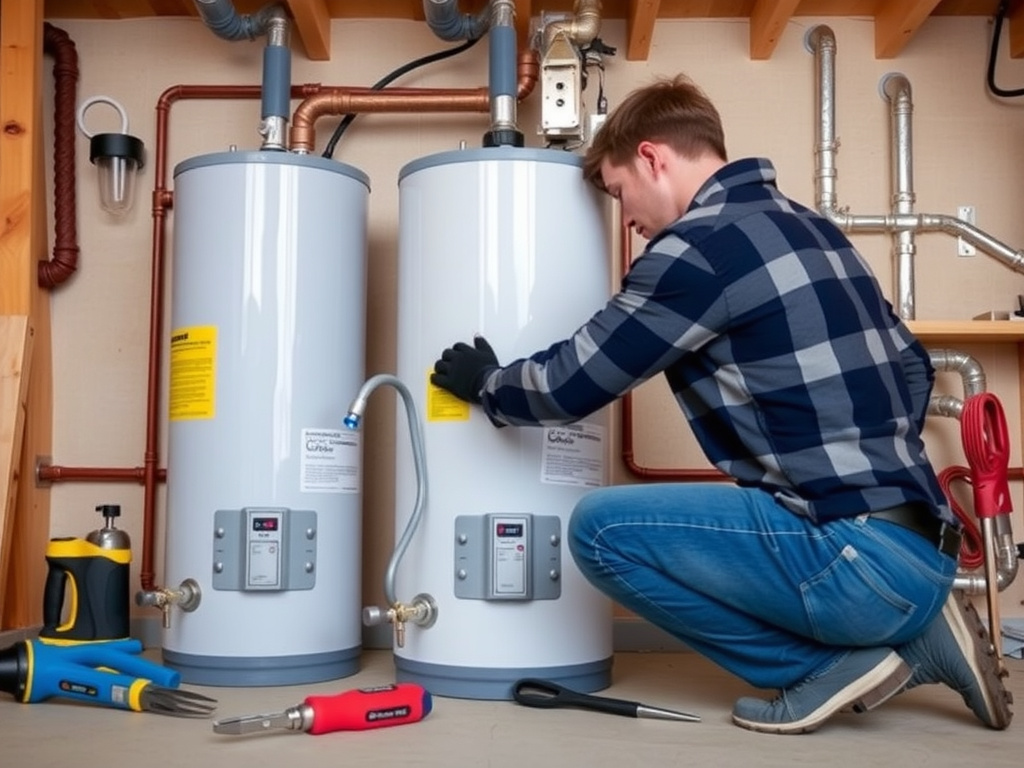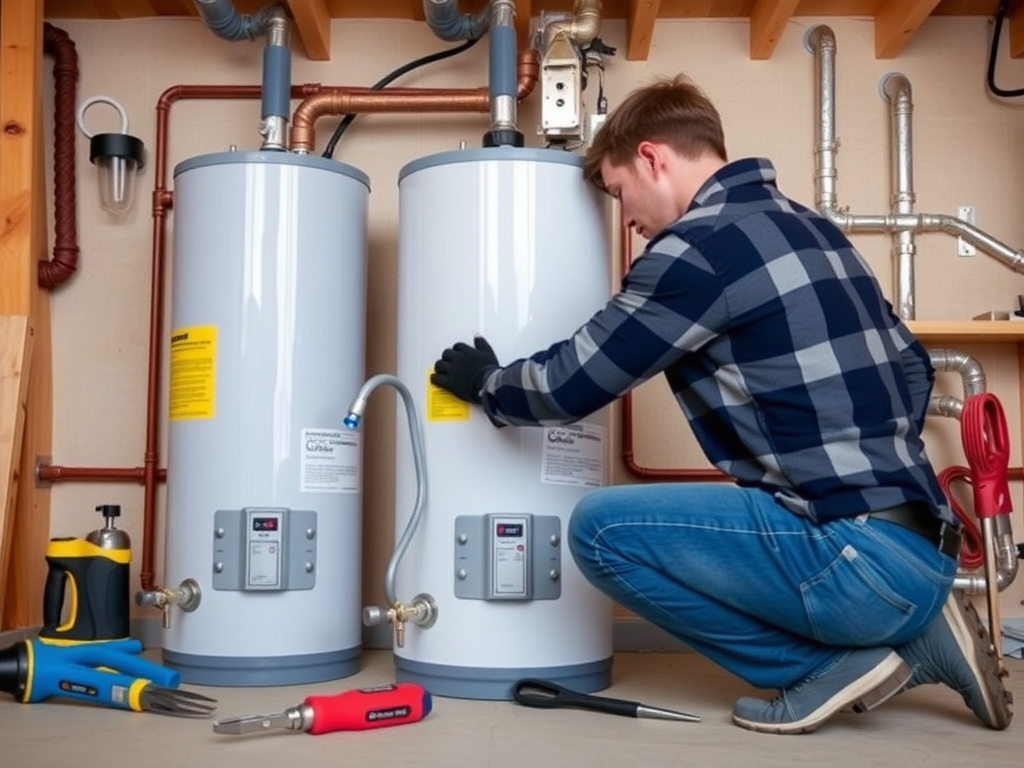Twenty-seven drips per minute. That’s what I counted on the kitchen floor at 2:14 a.m. in a 1998 semi-detached in Stoke-on-Trent. The sound wasn’t loud—just a steady, mocking tic-tic-tic—like a broken metronome set to “slow decay.” I’d been called out because the hot water had gone lukewarm at 7 a.m., then vanished entirely by noon. The homeowner, Mrs. Bell, kept muttering, “It’s only 12 years old. It shouldn’t die.” I knelt down, wiped the puddle with my sleeve, and saw the tell: rust blooming like coral around the lower union nut of the Honeywell 120V-50G tank. Not a leaky valve. Not a faulty thermostat. The tank itself had surrendered. I pulled out my phone, snapped a pic, and texted her: “It’s not broken. It’s done.” She cried. I didn’t blame her. That tank had given her showers for 12 Christmases, five kids’ bath times, and three generations of Sunday morning coffee. water heaters don’t die dramatically. They just stop showing up when you need them most.
I’ve installed, replaced, and diagnosed over 1,800 water heaters in my 14 years as a NICEIC-certified plumbing and heating engineer. I’ve seen Rheem 50-gallon models last 22 years in hard-water areas with annual flushing. I’ve watched Bosch 3000 Series units fail at 7 years because someone ignored the anode rod. I once spent three days in a terraced house in Brixton where the previous owner had buried the pressure relief valve under floorboards—no one knew it was there until the tank bulged like a balloon and cracked open during a winter freeze. That’s not just negligence. That’s a death sentence waiting for the right temperature. I’ve learned: lifespan isn’t about age. It’s about care, water quality, and whether you listen to the whispers before they become screams.
Quick Steps:
1. Check for rust stains near the bottom of the tank—especially around the drain valve.
2. Test water pressure with a gauge (ideal: 40–60 psi; above 80 psi = risk).
3. Drain a 1-gallon bucket from the drain valve—look for sediment. If it’s gritty like sand, flush or replace.
4. Inspect the anode rod (remove the hex cap on top)—if it’s thinner than a pencil, replace it or the tank.
5. Note the serial number. First two digits = year made. If it’s 12+ years old and showing any warning signs, plan for replacement.
How Long Do Water Heaters Actually Last?
Most manufacturers claim 8–12 years. Real-world experience tells a different story. A Hunter 50-gallon electric unit in a soft-water region with annual maintenance can hit 18 years. In contrast, a Rinnai tankless running on hard water without a filter can clog and die in 5. The numbers lie. The conditions tell the truth.
I once replaced a A.O. Smith 50-gallon in a Sussex cottage that had been installed in 1999. It had never been flushed. The sediment layer at the bottom was 3 inches deep—thick enough to insulate the bottom element. The element was still firing, but it was cooking through 3 inches of mineral sludge instead of water. Efficiency had dropped 40%. The homeowner thought it was “just slow.” It wasn’t. It was dying slowly, like a heart beating under a stone.
Water quality is the silent killer. Hard water (above 7 grains per gallon) deposits calcium and magnesium inside the tank. Over time, this builds a layer between the heating element and the water. The element works harder. It overheats. The coating fails. The tank corrodes faster. In areas like Birmingham, Leeds, or Derby, where water hardness exceeds 200 ppm, you’re fighting an uphill battle unless you install a water softener or flush annually.
Electric units tend to outlive gas ones—not because they’re superior, but because they have fewer moving parts. Gas heaters have draft hoods, burners, flue pipes, and pilot assemblies that collect soot, rust, and debris. A Rheem Performance Platinum 50-gallon gas unit, even with annual servicing, rarely lasts beyond 10–12 years in a dusty garage. An electric Honeywell 50-gallon dual-element can easily reach 15 if the anode rod is replaced every 4–5 years.
The Anode Rod: The Silent Guardian
Here’s what no one tells you: your water heater has a sacrificial lamb. The magnesium or aluminum anode rod sits at the top of the tank, slowly dissolving to protect the steel lining from corrosion. It’s designed to die so your tank doesn’t. But 90% of homeowners don’t know it exists.
I once worked with a plumber who swore the anode rod was “a marketing gimmick.” He replaced a tank every 6 years. Then he got curious. He removed the rod from a 10-year-old Bradford White 40-gallon and found it had completely vanished. No trace. The tank was already pitted underneath. He called me. We did a test: installed a new rod in a second identical unit. Five years later, that tank was still pristine. The other? Leaked through the bottom seam.
Anode rods cost £18–£32 at B&Q or Screwfix. Replacing one takes 90 minutes. You need a 1-1/16” socket wrench, a bucket, and the will to get your hands dirty. Do it every 4 years. If you’re in a hard-water area, do it every 2. If the rod is thinner than your thumb, replace it immediately. If it’s gone? You’re just waiting for the next drip.
Some pros swear by aluminum-zinc rods in areas with sulfur-smelling water—they reduce odor. I prefer magnesium for most homes. It’s more aggressive in corrosion protection. But if your water smells like rotten eggs, check your anode. A bad one can turn into a chemical reactor and turn your hot water into a spa of stink.
The Cost of Waiting: When Replacement Beats Repair
A leaking tank isn’t a repair job. It’s a warning. You can patch a valve. You can replace a thermostat. But once the tank itself corrodes, you’re gambling with your ceiling, your flooring, your insurance claim.
I saw a client in Kent who spent £240 replacing the upper heating element on his 11-year-old Worcester Bosch 120L electric. Three weeks later, the tank burst. Water flooded his downstairs bathroom, his study, and his neighbor’s kitchen. The repair bill? £8,200. His insurance paid, but his premiums jumped 37%. He lost his favorite rug, his antique desk, and his peace of mind.
Compare that to replacing the unit proactively. A Rheem Performance 50-gallon electric costs £580–£720 (including VAT) at Toolstation. installation by a certified engineer? £600–£800. Total: £1,200–£1,500. You get a 10-year warranty, 94% energy efficiency, and a tank that won’t surprise you at 3 a.m.
Gas units are trickier. A Rinnai RU199iN tankless system costs £2,200–£2,800 installed. But it lasts 20+ years, uses 30% less energy, and never stores water. The upfront cost hurts, but if you’re in a household of four or more, it pays for itself in 5–7 years. I installed one in a family home in Nottingham last year. Their old 40-gallon gas unit ran out of hot water after two showers. The new tankless gives endless supply. The wife cried again—this time from joy.
Safety Considerations and Legal Requirements
All water heater installations in the UK must comply with BS 7671 (IET Wiring Regulations) and Part G of the Building Regulations. Pressure relief valves must discharge to a safe location—not into a cupboard or under the floor. Drain valves must be accessible. Venting for gas units must meet Corgi-approved standards (now Gas Safe Register).
You cannot legally install a gas water heater yourself unless you’re a Gas Safe registered engineer. Even electric units require certification under Part P if they’re hardwired. Plug-in models (under 3kW) are exempt, but most domestic tanks are 3–12kW and must be fused at the consumer unit.
Warning: Ignoring pressure relief valve placement → tank rupture → scalding steam and water explosion → structural damage or death.
Safe alternative: Always route the relief valve discharge pipe to a visible, non-freezing location—like a floor drain or external gully—with no elbows or reductions. Test it monthly by lifting the lever.
If you smell gas near the unit, turn off the supply at the main valve, open windows, and call Gas Safe immediately. Never use a lighter to check for leaks. Use soapy water on joints—bubbles mean gas escape.
FAQ
How do I know if my water heater is nearing the end of its life?
Look for rust around the base, rusty water, longer heating times, or unusual noises like popping or rumbling. If it’s over 10 years old and showing any of these, it’s not a question of “if” but “when.” I once replaced a 13-year-old Honeywell that made a noise like a kettle boiling underwater—turned out the sediment had formed a rock layer under the element. It wasn’t failing; it was singing its last song.
Can I extend my water heater’s lifespan without replacing it?
Yes—if you’re proactive. Flush the tank annually. Replace the anode rod every 4–5 years. Install a water softener if hardness exceeds 150 ppm. Keep the thermostat at 120°F (49°C)—higher temps accelerate corrosion. I’ve seen tanks last 18 years in households that did this. The ones that didn’t? Gone by 8.
How much does it cost to replace a water heater in the UK?
A standard 50-gallon electric unit costs £580–£720 (parts only). Installation runs £600–£800. Tankless gas systems start at £2,200 installed. Budget £1,300–£1,800 for a full replacement with removal and disposal. B&Q and Screwfix offer £100–£150 discounts on models during sales (March and September).
Should I choose electric or gas?
Electric is simpler, cheaper to install, and lasts longer. Gas is faster-heating and better for large households but requires venting, gas lines, and more maintenance. If you’re in a new build with solar PV, electric is ideal. If you’re in a rural home with high gas prices, consider a heat pump water heater—Stiebel Eltron models cut energy use by 70%.
Can I install a water heater myself?
Electric units under 3kW (like small under-sink models) can be plug-in. Anything else requires a Part P-qualified electrician. Gas units? Never. You’ll void the warranty, risk carbon monoxide poisoning, and face fines up to £5,000. I’ve seen homeowners try. They always regret it.
What brand lasts the longest?
In my experience, Rheem and A.O. Smith lead in durability, especially with their glass-lined tanks and superior anode rod design. Honeywell is solid for electric. Rinnai tankless units win for longevity if maintained. Avoid no-name brands from Amazon—many use thin steel and cheap components. I replaced one last year that cracked after 14 months. The warranty was void because it wasn’t installed by a certified engineer.
I don’t believe in waiting for disasters. Water heaters don’t die in a single night—they whisper for years. You just have to listen. Check the drain valve. Test the pressure. Look for rust. Replace the anode. Don’t wait for the drip. Don’t wait for the flood. Act before the alarm sounds.
Plan your replacement now. Schedule a flush this autumn. Take 15 minutes to inspect the tank. Your ceiling, your wallet, and your sleep will thank you.


